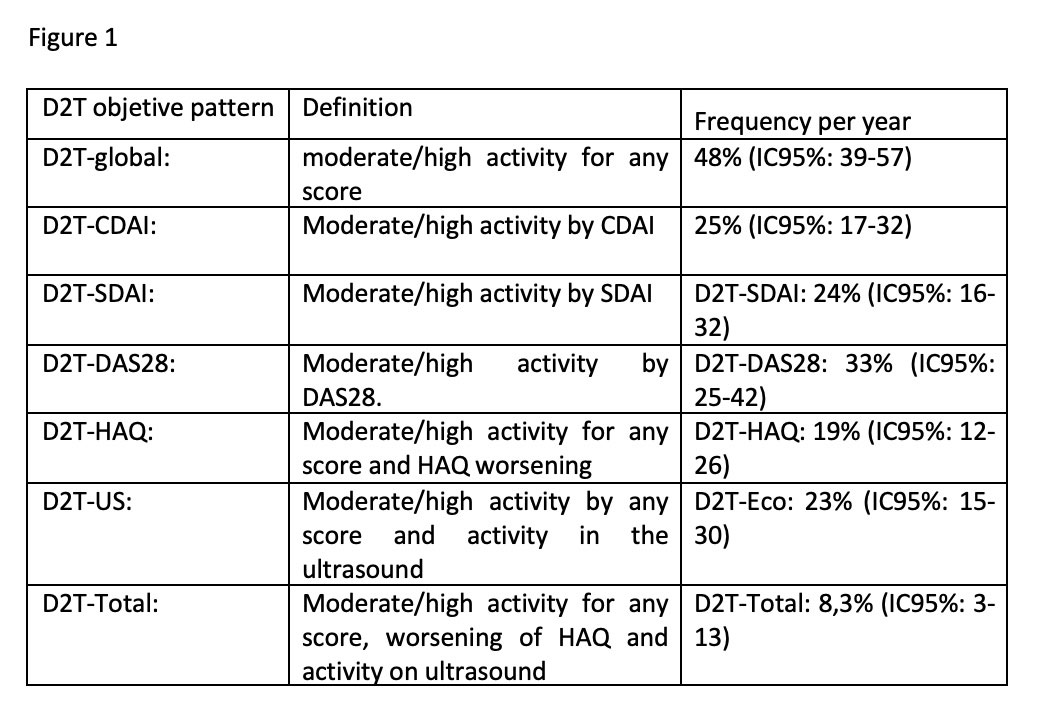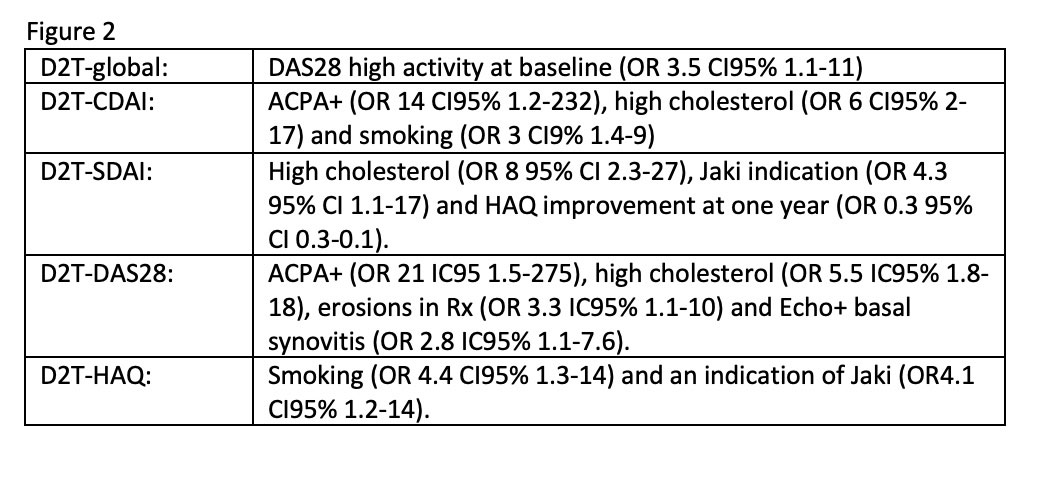Session Information
Date: Monday, November 14, 2022
Title: RA – Treatment Poster IV
Session Type: Poster Session D
Session Time: 1:00PM-3:00PM
Background/Purpose: Difficult-to-Treat Rheumatoid Arthritis (RA) (D2T), is a concept recently defined by EULAR, it refers to patients who do not achieve the therapeutic target, who have failed two biological or Jaki and present difficult management.
Objectives: To estimate the frequency of different objective patterns of D2T in a one-year follow-up. To analyze the RA features at basal and one year associated with D2T.
Methods: A prospective cohort study, where patients diagnosed with RA recruited from a comprehensive program was included. In the first visit (baseline) the following were performed: blood test, X-ray, ultrasound, and an interview where sociodemographic data, clinical data, and clinimetry; each evaluator was unaware of the data from the other studies performed. One year later they were evaluated in the same program with the same procedures and the treatment carried out by their rheumatologist during that period was recorded. Compliance with D2T criteria was established according to the failure of two biological or Jaki and the objective parameters and classification defined in figure 1. Statistical analysis: descriptive statistics, Chi2 test, Fisher’s exact test, Student’s T-test, and Mann Whitney were performed. Multivariate analysis of logistic regression of the significant variables at baseline and at one year for each objective definition of D2T.
Results: We included 120 patients with RA who completed the baseline visit and at one year, 77% were a female, mean age of 52 years (SD: 13), disease duration 30 months (IQR: 12-70), 49% had diagnosis less than 2 years, 84% seropositive. The frequency of D2T RA in each definition is shown in figure 1. In the univariate analysis, in general, seropositivity, high cholesterol, the presence of radiographic damage, the indication of biologicals, and smoking at baseline were associated with the development of RA D2T, and positive ultrasound at a year was the variable associated with D2T, and HAQ improvement was negative. Multivariate analysis for each objective definition of D2T with their respective independent associations is shown in figure 2.
Conclusion: The frequency of RA D2T in our cohort at one year of follow-up was between 8% and 48% depending on the objective definition used, it was independently associated with high activity at baseline, ACPA seropositivity, high cholesterol, smoking, erosions on Rx and indication of Jaki. And after a year with activity in ultrasound and in a negative way with the improvement of the HAQ.
To cite this abstract in AMA style:
Sanchez-Prado E, Perez r, Cuellar L, mareco j, Ruta S, Magri S, Garcia Salinas R. Difficult to Treat Rheumatoid Arthritis: Prevalence of Different Objective Patterns, Predictive Characteristics, and Associated Factors in 1-Year Follow-Up [abstract]. Arthritis Rheumatol. 2022; 74 (suppl 9). https://acrabstracts.org/abstract/difficult-to-treat-rheumatoid-arthritis-prevalence-of-different-objective-patterns-predictive-characteristics-and-associated-factors-in-1-year-follow-up/. Accessed .« Back to ACR Convergence 2022
ACR Meeting Abstracts - https://acrabstracts.org/abstract/difficult-to-treat-rheumatoid-arthritis-prevalence-of-different-objective-patterns-predictive-characteristics-and-associated-factors-in-1-year-follow-up/


